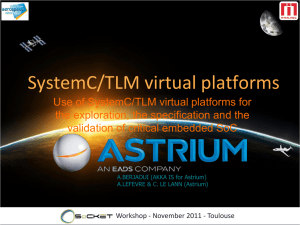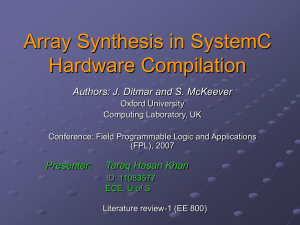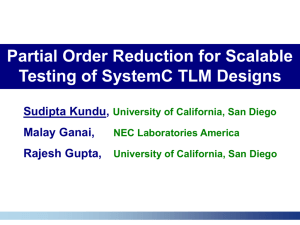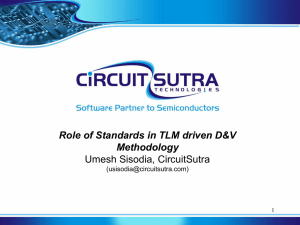PowerPoint Template
advertisement
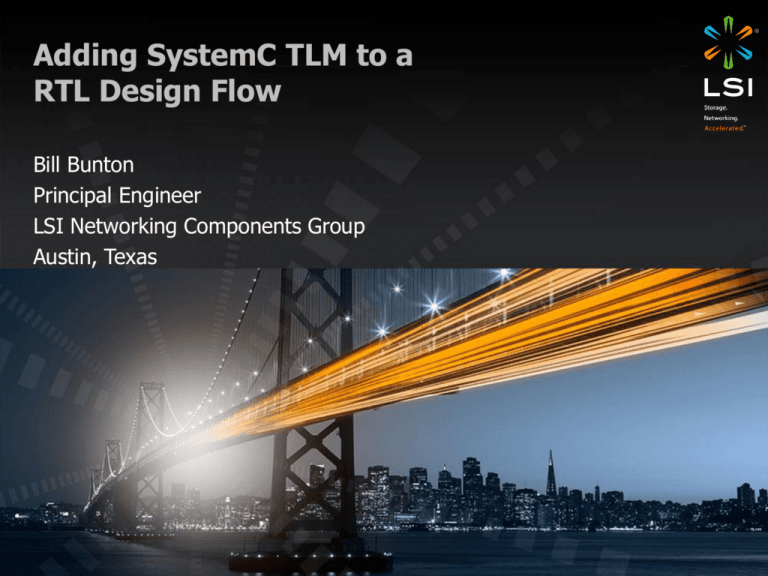
Adding SystemC TLM to a RTL Design Flow Bill Bunton Principal Engineer LSI Networking Components Group Austin, Texas Electronic System Level (ESL) Design Raises the level of design abstraction Early performance model validates architecture concepts Allows engineers to create, change, and validate concepts without implementing RTL Supports hardware/software co-design Virtual Prototype for early software bring-up ESL is supported by a collection of Accellera standards, tools, and concepts – – – – – SystemC & TLM SystemRDL (Register Description Language) Control and Status Register code generators SystemC & RTL co-simulation RTL to SystemC conversions 2 What is SystemC IEEE Standard 1666-2011 SystemC It’s not an RTL (SystemVerilog or VHDL) SystemC allows higher level of abstraction than RTL SystemC allows much faster simulation SystemC extends C++ with classes, macros, and adds a scheduler, providing – Hierarchy and structure familiar to hardware designers – Block-to-Block communications – Hardware data types – Event driven scheduler that allows concurrent execution Existing IP New IP Vendor IP TLM2 Sockets & Generic Protocol Primitives Mutexs, FIFOs, Signals Simulation Kernel Threads & Methods Events C++ Channels & Interfaces Modules & Hierarchy Data Types Logic Integers Fixed Point STL SystemC and RTL co-simulation is supported by all suppliers 3 What is Transaction-Level Modeling (TLM) TLM is a high-level approach to modeling digital systems that separates: OSCI SystemC TLM-2 available June 2008 IEEE 1666–2011 includes TLM-2: – Sockets for block-to-block interconnect – Generic protocol (memory mapped bus) SystemC TLM defines two modeling styles – Loosely-timed (LT) • Sufficient timing detail for Virtual Prototypes • Temporal decoupling (run ahead) • Uses direct memory interface (DMI) – Approximately timed (AT) • Sufficient timing detail for architecture exploration • Processes run in lock-step with simulation time RTL Performance Models Interconnect Accuracy – Details of interconnect (communication) – Details of functionality (computation) AT CA Virtual Prototype LT UT Functional Accuracy UT -- Untimed LT -- Loosely timed AT -- Approximately timed CA -- Clock & Pin Accurate (D Gajski 2003) 4 Initial Conditions: RTL and Software Design Flows Exist Your development process is proven You have customers using generations of your chips Chip complexity is growing more processors and more RAMs, all running faster Re-spins will be very costly Customers need the next generation systems sooner Each new system has more and more software Software is always the last to finish 5 Example Project Design Flow System On a Chip (SoC) Requirements Specification Hardware Design FPGA Prototype Bring-Up Software Ship Tape-out First Si 6 Example Project Design Flow System On a Chip (SoC) Requirements Requirements Specification HW Specification Hardware Design FPGA Prototype Hardware Design FPGA Prototype Bring-Up FPGA Prototype Bring-Up Software Software Ship Ship Tape-out First Si 7 Where Can You Start ? Three Common SystemC TLM Use-Cases System Architecture – – – – Architecture exploration System performance models Functional block development System architecture validation Software Bring-Up – – – – Virtual Prototype Early software development System-level performance modeling Software performance optimizations Logic Design – – – – Design of High Level Synthesis (HLS) Replace RTL for design entry Tools optimize structure Power aware synthesis 8 System Architecture 9 Traditional System Architecture Requirements provided by marketing New algorithms developed using MATLAB, C, or C++ System architecture Requirements and specification Block-level partitioning Interconnect selection or definition Performance requirements for blocks and shared resources – Power and area allocation – Identify needed IP (build or buy) – Block-level design specification – – – – Documents & email Algorithm Details Requirements System Specification Block Level Requirements Experience, Reviews & Spreadsheets Design Specification Design Reviews 10 System Architecture Modeling Objectives Architecture Optimization – – – – Validated system-level block diagram Optimized interconnect structure Bottleneck analysis Establish interconnect behavior • Bandwidth • Latency • Priority – Allocate system resources • Bandwidth • Priority Validate Requirements – Performance – New functions – Buffering Requirements 11 Performance Model Block Diagram Traffic Generator Traffic Generator Traffic Generator Traffic Generator Traffic Generator Traffic Generator Coverage and Performance Metrics Protocol-Checker DDR3 Controller Cache Cache Cache Cache Cache Cache Cache Cache Memory Subsystem Interconnect DDR3 Controller 12 SystemC Performance Model Construction SystemC Approximately Timed (AT) modeling style – Non-blocking transport with multiple timing points – Processes run in lock-step with simulation time Probably does not include Software Specialized traffic generators model functional blocks and software IP blocks come from multiple sources – New and Existing AT models – Supplier’s AT models – RTL Converted to SystemC (faster than RTL) – RTL (very slow simulation) Includes simulation instrumentation – Performance – Functional coverage – Protocol-checker 13 SystemC Performance Modeling Results Optimized interconnect structure Bottlenecks identified and corrected System resource allocation Products – Bandwidth – Latency – Priority Block-level performance requirements Test bench for tracking performance Foundation for future system sodels Domain-specific traffic generators Reusable 14 SystemC Performance Modeling Results Optimized interconnect structure You can’t trust Bottlenecks identified and corrected Performance System resource allocation Models Products – Bandwidth – Latency – Priority Block-level performance requirements Test bench for tracking performance Foundation for future System Models Domain Specific Traffic generators Reusable 15 New Functional Block Architecture Modeling Objectives Capture executable functional description Verify functional behavior Verify functional performance Define hardware and software interfaces – Control and Status Registers – Shared data structures Explore block-level structures, functions, and storage Identify and model resource contention Size FIFO and buffer memories Eliminate low-level details from paper specification SystemC Test Bench 16 Bus Functional Model FIFO FIFO Ethernet MAC Functional Logic Block Bus Initiator PHY FIFO FIFO Ethernet MAC Functional Logic Block Ethernet Environment Model Functional Block Architectural Modeling CSR Block SystemC Test Bench 17 New Functional Block Architectural Modeling Construction SystemC Approximately Timed (AT) modeling style SystemC environment provides C++, SystemC, and TLM library components – – – – C++ Standard template library SystemC data types FIFO Payload event queues (PEQ) Model implementation using – New functions – Sub-block reuse (arbiters and pipeline models) – Known accurate TLM interfaces Vender supplied sub-block models Mix of TLM generic & system unique TLM protocols Code generator provided SystemC Control and Status Registers (CSR) Configurable delays allow exploration and tracking of RTL implementation Test bench models hardware and software environment Test bench includes directed and constrained random tests 18 New Functional Block Architectural Modeling Results Executable functional model of the new design Documentation and test for the most active CSRs Functional test bench Performance parameters for feedback to system performance model Complete and detailed structure for RTL design Design base for High Level Synthesis (HLS) Near-complete model for a Virtual Prototype Functional test for RTL and HLS implementation Reference model for SystemVerilog RTL test bench System unique TLM protocols New sub-components for future models Products Reusable 19 Software Bring-Up 20 Traditional Software Bring-Up Hardware team implements RTL Software team continues working on previous project Design Specification Communication Initial Software bring-up waits for a Hardware Prototype Requires Completed RTL – Hardware emulation – FPGA prototypes Hardware prototype shortcomings Only a limited number of prototype systems available Difficult to fit complete SoC on prototyping hardware Prototypes run at a reduced clock rate I/O clock-rates may be fast or slow relative to prototype core clock – Low-level physical interfaces may not be the same as ASIC – – – – Final software bring-up and debug requires complete System on a Chip Not Complete SoC Timing & Function Not 100% Accurate Always True 21 Virtual Prototype Model Objectives Minimize post-silicon software delays (deliver product sooner) Allow time for interface refinement before RTL design freeze Start software bring-up and debug as early as possible Provide a superior software debug environment Provide a bit-accurate prototype of the system Favor execution speed over fine-grain operation ordering May have performance-accurate mode 22 SystemC Virtual Prototype Model ISS ISS ISS Packet Content Inspection Security System Processor Ethernet & Switch DDR3 Controller Cache Cache Cache Cache Cache Cache Cache Memory Subsystem Interconnect Cache ISS Packet Processor DDR3 Controller 23 Virtual Prototype Model Construction SystemC Loosely Timed (LT) modeling style – Blocking transport with only two timing points – Temporal decoupling to allow processes to run ahead of simulation time – Direct memory interface (DMI) for high-speed memory access Use vendor-supplied processor models (ISS) Reuse system performance model structure and memory subsystem Speed up AT functional block by adding – – – – Blocking transport Debug transport Direct memory interface Optimized functional implementations for speed Implement new LT models as needed for a complete system simulation Use a code generator to implement complete CSRs for all blocks Provide configuration options to select AT or LT simulation mode 24 Virtual Prototype Model Results Pre-silicon full system model of software for software bring-up Full system model for customer application development Application performance optimization Simulation prototypes are less expensive than hardware emulation LT only block can be converted LT/AT for future performance modeling AT and LT blocks are a design base for High Level Synthesis (HLS) Virtual Prototype can be configured for performance modeling Foundation for next generation Virtual Prototype Products Reusable 25 Virtual Prototype Model Results Pre-silicon full system model for software for Can this thing software bring-up reallycustomer boot application Full system model development Linux? Application performance optimization Simulation prototypes are less expensive the hardware emulation LT only block can be enhanced (AT) for future performance modeling AT and LT blocks are a design base for High Level Synthesis (HLS) Virtual Prototype could be configured for performance modeling Foundation for next generation Virtual Prototype Products Reusable 26 Logic Design 27 Traditional Logic Design System architecture team defines requirements – – – – Function Performance Power and area allocation bandwidth & priority RTL team creates design specification – HW/SW interface definition – Functional sub-block description – Buffer and FIFO sizing RTL team implements micro-architecture Verification team creates test environment Hardware team achieves design closure by iterating – Micro-architecture changes – RTL-to-gates compilation Requirements RTL Design Specification RTL & Test Bench Implementation Design Closure Iterations 28 Design of High Level Synthesis (HLS) Objectives Let the tool do the implementation of RTL micro-architecture Use architecture or Virtual Prototype model as design base Use algorithms written in C or C++ as functional base Eliminate RTL implementation of microarchitecture – Pipelining and state-machines – FIFO and arbiters SystemC Test Bench Create design that can be easily optimized – Speed – Area – Power 29 Bus Functional Model FIFO FIFO Ethernet MAC Functional Logic Block Bus Initiator PHY FIFO FIFO Ethernet MAC Functional Logic Block Ethernet Environment Model Design of High Level Synthesis (HLS) CSR Block SystemC Test Bench 30 Design of High Level Synthesis (HLS) Construction Existing SystemC models should be used as a design base. – – – – Paper spec C C++ algorithm An existing SystemC LT model AT models may over constrain – – – – not the best option better better still may be good Synthesis tools cannot support the full richness of SystemC and C++ – Capabilities differ from vender to vendor SystemC models may require restructuring for synthesis Synthesis is controlled by directives and a technology library Synthesis results can be optimized for – Speed – Power – Area Synthesis-generated RTL merges with existing RTL design flow 31 Design of High Level Synthesis (HLS) Results Optimized RTL implementation Synthesizable SystemC code for reuse – Different ASIC technologies – Different optimizations of speed, area and power Product Reusable SystemC models for future use – Performance modeling – Architectural exploration SystemC models for functional design evolution 32 Observations and Recommendations 33 Recap Each use-case is beneficial when used independently – System Performance Models • Optimized system structure • Improved block-level requirements – Block-level Architecture Modeling • Executable functional description • Early functional validation – Virtual Prototype • Minimize post-silicon software delays • Allow early software feedback – High Level Synthesis • Focus on function, not micro-architecture • Easy optimization of speed, area and power A single model implementation can be used by multiple use-cases SystemC models are reusable across projects and technologies Benefits multiply as more use-cases are incorporated into a design-flow 34 Example RTL Project Design Flow System On a Chip (SoC) Requirements Specification Hardware Design FPGA Prototype Bring-Up Software Ship Tape-out First Si 35 Example ESL Project Design Flow System On a Chip (SoC) Architecture Specification Performance Modeling Hardware Design FPGA Prototype Virtual Prototype Bring-Up Software Ship Tape-out First Si 36 What To Do At DAC Attend Accellera sponsored events at DAC – – – – – Breakfast and Town Hall Meeting IP XACT Tutorial Multi-Language Birds-of-a-Feather Meeting IP Protection / P1735 Birds-of-a-Feather Meeting North American SystemC User Group (NASCUG) meeting Get involved with the Accellera design standards activities Look for more SystemC presentations Visit the DAC exhibitors and investigate – – – – – – – – SystemC training SystemC development environments SystemC & RTL co-simulation environments RTL to SystemC conversion tools IP packages with SystemC models IP packages with SystemRDL Code generators for CSR (SystemC and RTL) High Level Synthesis (HLS) 37 Visit the Accellera Members DAC Exhibitors ARM Ltd. Atrenta, Inc. Cadence Design Systems Doulos Ltd. Duolog Forte Design Systems Fraunhofer IIS/EAS IBM Intel Corporation Jasper Design Automation Magillem Design Services Mentor Graphic Semifore, Inc. Synopsys Vayavya Labs 38 After DAC Convince your organization that ESL and SystemC will – Increase productivity – Improve quality – Shorten schedules Select tools suppliers Schedule SystemC training for hardware and software engineers Identify and implement an ESL pilot-project Use SystemC code reviews as a training tool Document your ESL design-flow based on best practices Define SystemC code guidelines for each design style – – – – Transaction-Level modeling interfaces Loosely timed models Approximately timed models High Level Synthesis Continue improving the ESL flow and update documentation Merge the ESL flow with the existing design-flow 39 Questions? 40

